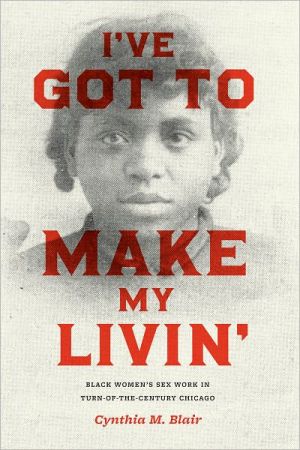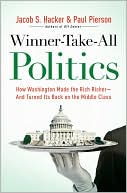I've Got to Make My Livin': Black Women's Sex Work in Turn-of-the-Century Chicago
For many years, the interrelated histories of prostitution and cities have perked the ears of urban scholars, but until now the history of urban sex work has dealt only in passing with questions of race. In I’ve Got to Make My Livin’, Cynthia Blair explores African American women’s sex work in Chicago during the decades of some of the city’s most explosive growth, expanding not just our view of prostitution, but also of black women’s labor, the Great Migration, black and white reform...
Search in google:
For many years, the interrelated histories of prostitution and cities have perked the ears of urban scholars, but until now the history of urban sex work has dealt only in passing with questions of race. In I’ve Got to Make My Livin’, Cynthia Blair explores African American women’s sex work in Chicago during the decades of some of the city’s most explosive growth, expanding not just our view of prostitution, but also of black women’s labor, the Great Migration, black and white reform movements, and the emergence of modern sexuality. Focusing on the notorious sex districts of the city’s south side, Blair paints a complex portrait of black prostitutes as conscious actors and historical agents; prostitution, she argues here, was both an arena of exploitation and abuse, as well as a means of resisting middle-class sexual and economic norms. Blair ultimately illustrates just how powerful these norms were, offering stories about the struggles that emerged among black and white urbanites in response to black women’s increasing visibility in the city’s sex economy. Through these powerful narratives, I’ve Got to Make My Livin’ reveals the intersecting racial struggles and sexual anxieties that underpinned the celebration of Chicago as the quintessentially modern twentieth-century city. Catalog "I've Got to Make My Livin' is a splendid study of the historical interplay of city space, race, class, gender, and sexual politics during the industrial era. In this engaging work, Cynthia Blair creates a compelling portrait and persuasive argument for black women's participation in the underground sexual economy."-Elizabeth Clement, University of Utah
I've Got to Make My Livin'\ Black Women's Sex Work in Turn-of-the-Century Chicago \ \ By CYNTHIA M. BLAIR \ The University of Chicago Press\ Copyright © 2010 The University of Chicago\ All right reserved.\ ISBN: 978-0-226-05598-5 \ \ \ Chapter One\ The Sources of Courtesanship": African American Women's Wage Work, the Informal Economy, and the Search for Independence \ In 1870 a Chicago Times reporter accompanied a group of investigators who ventured into Chicago's sex district to discover the thoughts of madams and prostitutes on a matter of great public concern. The Common Council was in the throes of a debate to determine whether or not Chicago should institute a system of registering and inspecting its houses of prostitution. While the unidentified interviewers sought to elicit the opinions of brothel keepers regarding the proposed system of regulating their businesses, the reporter's concerns were elsewhere. He seemed utterly fascinated with the group of women he encountered—largely white madams in charge of Chicago's most prosperous houses of prostitution. Well-dressed and gracious to their curious visitors, these women were thoughtful and unrestrained in expressing their ideas about regulation and prostitution more generally. To the question "What induces a girl to turn out?" one prostitute answered, "Love of dress, and a desire to go more; [and a] love of liberty." The committee leadingly asked one brothel keeper, "Don't 99 in 100 women turn out for love of money and good clothes?" to which she succinctly responded, "Yes." It is not clear whether these women sincerely believed these statements or if they were echoing popular explanations for the growth of the sex trade in cities like Chicago. Nevertheless, the reporter culled through the numerous responses of prostitutes and madams to the investigators' questions and promised to reveal "Some Startling Facts" about "The Sources of Courtesanship."\ Yet to the Times reporter the scope of the interviewers' examination of prostitution in Chicago proved incomplete. After the team of investigators concluded their task, the reporter went out on his own into what he described as a "dark and dank" area of the red-light district. "Winding in and out, stumbling up and down, splashing in mud, and staggering over broken steps and nameless obstacles, there were visited haunts whose character would never be conceived by the wildest and most prurient imagination." Crowded together in this dirty and ominous terrain were the houses of prostitution in which black and white women worked side by side. "Obese wenches in the arms of sodden white men; fair young girls nestling close to the side of sooty negroes—such were the aspects of the social problem as it presented itself in the lower haunts of this fair city." He eventually approached one black prostitute and asked, "Well aunty ... What shall we do with you women, eh?" Apparently unruffled by the disdain lurking behind his question, she responded frankly, "Well, boss, we must live anyhow."\ With her brief and matter-of-fact reply, this nameless black woman encapsulated the predicament that led many women to choose employment in Chicago's sex economy. Some prostitutes may have regarded prostitution as a means of attaining a degree of freedom from the strictures of family and marriage; others may have chosen sex work as a way to earn enough money to allow them to participate in the city's bustling consumer economy, an arena open mostly to middle-class wives and daughters. Yet for many women laboring "in the lower haunts" of Chicago's sex economy, especially poor African American women, prostitution provided something more basic—it was a means of survival.\ African American Women's Wage Work\ In the last decades of the nineteenth century, black women appear to have been disproportionately represented among Chicago's prostitutes. In 1890 African Americans made up a meager 1 percent of the city's population, and 2 percent of "gainfully" employed women were black. Yet black houses of prostitution accounted for 12 percent of all brothels listed in the Sporting and Club House Directory, an 1889 guidebook directed at white men looking for safe and discreet sexual pleasure in the city. Black women's disproportionate representation among Chicago's prostitutes may in part be attributable to the racial attitudes of the directory's compiler. When it came to determining the occupations of African American women, he may very well have been like most white Americans at the end of the nineteenth century, who consumed and believed the varied portrayals of black women's innate sexual depravity. These portrayals may have contributed to the frequency with which this investigator branded black women with the label of "prostitute." In fact, at the end of the century the commonplace usage of this characterization of black women by white politicians and political writers, journalists, and historians, North and South, helped galvanize African American women to organize a club movement that would eventually form the basis of the National Association of Colored Women.\ The data culled from the Sporting and Club House Directory, however imprecise, shed critical light on the workings of race in prostitution and the limits of black women's wage work in the nineteenth-century city. First, even assuming that some overcounting occurred in the brothel directory, the numbers nevertheless point to the inordinate presence of black women among Chicago's sex workers and entrepreneurs. Second, African American women were highly visible inhabitants of the city's sex terrain. Whether they occupied the "dark and dank" recesses of the city (as characterized by the Times reporter) or shared the bright and boisterous streets at the center of the sex district (as reflected in the sporting directory), black women were noticeably active participants in Chicago's sex trade. Finally, for untold and perhaps unknowable numbers of African American women, sex work provided a viable, often necessary, means of earning money in an industrializing and rapidly expanding urban economy.\ Some black women who became sex workers were likely longtime residents of the city; most, however, were among the growing number of African Americans who migrated to Chicago after 1880. In 1880 and 1900, the vast majority of black brothel workers were born outside Illinois. Like thousands of other migrant women and men, they had come to the city hoping to find the makings of a life better than what they had left behind. They sought economic opportunity for themselves and very often for their families back home, and they hoped to experience the social freedoms that life in a northern city promised. Once in Chicago they each confronted the often overwhelming financial demands of city living. Black men seeking opportunities in the city's industrial economy also faced a limited job horizon. White employers relegated most black men to work as unskilled laborers in the city's factories or as porters, waiters, and janitors in the bustling enterprises of this fast-growing marketplace. Yet navigating a job market rigidly structured by both race and gender, black women faced an even narrower range of job opportunities. Most found employment as low-wage servants in downtown businesses or in the homes of Chicago's growing white middle class.\ In the late nineteenth century, virtually all of Chicago's working black women toiled as service workers. In 1890 black women made up 4.3 percent of all female servants, roughly four times their proportion of the city's women. Despite black women's overrepresentation among servants, white housewives, restaurateurs, and hotel managers were more likely to hire immigrant women to fill openings for cooks, waitresses, charwomen, laundresses, and general help. Foreign-born white women—the largest proportion of whom came from Germany, Ireland, Sweden, and Norway—made up 66 percent of all women so employed. Native-born white women made up the balance of women in domestic and personal service. In such northeastern cities as Boston and Philadelphia, as well as in southern cities and towns, with older black communities and with a longer tradition of hiring black women as household workers, opportunities for domestic employment abounded. Compared with women working in these cities, black women who moved to Chicago in search of employment faced a particularly constricted job market. These limited prospects may have checked the rate at which black women moved to Chicago. Until 1900 black women lagged behind black men as migrants to the city.\ By 1900 employment opportunities gradually widened, both within and beyond household service. In 1890, 77 percent of working black women in Chicago held jobs as service workers, and 16 percent worked as semiskilled laborers. By 1900, when 71 percent of working black women labored in household or other personal service, their proportion of the city's service workforce had nearly doubled, reaching over 8 percent. In addition to gains in the service sector, 20 percent of black women held jobs as semiskilled workers. Yet even semiskilled workers were unable to escape black women's traditional work entirely. They either found jobs in the expanding fields of mechanized domestic labor—such as in commercial laundries—or they secured positions in domestic fields previously closed to them. Of the 998 African American women classified as semiskilled in 1900, 55 percent were seamstresses and dressmakers, and 26 percent were housekeepers in hotels, commercial rooming houses, or boardinghouses. Few held factory jobs. Unlike white women, who after 1880 enjoyed a broadening array of commercial and industrial occupations, black women found few paths into the diversifying economies of the city.\ African American women came to Chicago in the last decades of the nineteenth century aware that they would more than likely be employed as domestic servants, although many might have hoped otherwise. They arrived with the belief that, unlike in the towns or rural districts of the South and Midwest, once in the city they could make the restricted field of service suitable to their needs. Their concentration in domestic work, however, was rarely a comfortable fit. Whether employed as household domestics, as cooks or waitresses in restaurants, or as charwomen in downtown office buildings and hotels, black female service workers labored under adverse conditions. In the homes of middle-class and wealthy white families, black women endured long, grueling hours, limited free and family time, and, too often, the sexual advances of male employers. As cooks in downtown restaurants, their employers gave them the least desirable and most strenuous tasks. As cleaning women in office buildings and hotels, black women worked under physical conditions more onerous than those suffered by their white female coworkers. And, more than any other group of service workers, black women consistently toiled at the lowest rung of the earnings ladder.\ With considerable ingenuity and often with some sacrifice, black women struggled to mold the low wages and limited occupations of service work to suit their personal aspirations, economic needs, and family obligations. This struggle eventually transformed urban domestic labor relations. After the turn of the century, black women domestic workers across the country asserted their preferences for work that afforded them the most flexibility. Like their counterparts elsewhere, black women in Chicago increasingly preferred day work, living out (i.e., not living in the homes of their employers), and the relative independence of laundry work.\ In the late nineteenth century, however, the obstacles African American women faced in their efforts to find employment, make a living, and at the same time defend their independence and dignity within the urban wage system pushed some to look elsewhere for their money. Peripheral to a thriving industrial economy and restricted to onerous and low-paying domestic employment, many black working women struggling to make ends meet moved beyond wage work and ventured into the city's underground economy. For many women, work in this alternative urban economy entailed selling sexual favors in Chicago's thriving sex trade.\ The Informal Economy\ In addition to those categories of labor that census takers recognized as "gainful employment," there were numerous other ways of earning money within Chicago's South Side economy. Only the shadows of this world of work appear in government statistics of gainful employment. Nonetheless, the informal, or underground, economy has historically been a vital arena of economic activity, encompassing an array of endeavors. In turn-of-the-century Chicago, it was a dynamic arena of commerce, sustaining individuals and neighborhoods and affording black women opportunities unavailable to them in the legal wage economy.\ The concept of the "informal," "underground," or "shadow" economy was formulated in the 1970s and has since undergone a great deal of theorization. Economists, anthropologists, and sociologists developed the term as a way to bring into analytical view areas of labor and modes of income generation existing outside formal wage relations. In the late nineteenth century, as in the late twentieth, the informal economy was a network of economic endeavors and community relations that supported both the generation of income and the exchange of goods and services outside officially sanctioned or regulated networks of exchange. Black women and men who worked in the informal sector of the urban economy took advantage of the needs of both black community members and whites living beyond community borders for a variety of goods and services. Hot foods peddled on busy street corners, medicinal tinctures prepared at home and advertised through neighborhood information networks, "policy" shops concealed in kitchens, basements, and cigar shops, gambling dens tucked away in the back rooms of barbershops and saloons—each of these economic undertakings represents a strategy by which black city dwellers earned money outside the wage economy. Prostitution was situated along a continuum of economic enterprises, legal and illegal, that women and men developed to earn money in turn-of-the-century Chicago.\ As the prominence of prostitution suggests, much of the urban informal economy was linked to men's leisure. In the late nineteenth century, numerous commercial leisure establishments emerged to cater to the recreational needs of working black men who had a bit of discretionary income. Saloons were the most plentiful of such places. These resorts offered a variety of diversions and services in exclusively male social environments. While many saloon proprietors aspired to respectability, others flouted such standards. Several black saloon owners profitably blurred the line separating reputable businessman and purveyor of illicit entertainment. Savvy saloon owners hoping to earn more than the legitimate sale of alcohol could bring opened up back rooms to such activities as billiards, pool, card games, and craps. In 1890 John "Mush-mouth" Johnson and a partner opened one of the most popular gambling saloons among Chicago's black sporting men. Robert Motts ran his own saloon and gambling den in the 2700 block of State Street. Both Johnson and Motts gained considerable notoriety and wealth as proprietors of both legitimate and illegal recreational enterprises. Establishments such as these provided jobs for black men who, like women, sought alternatives to low-paying, menial employment. For the black working men who frequented their back rooms, these and other gambling saloons held out the remote possibility of multiplying—and the less remote possibility of losing—the slim pay earned in the wage economy.\ Prostitution, like gambling, catered to the recreational needs of men. It rivaled gambling as one of the largest and perhaps the most visible sector of the urban informal economy. Unlike gambling, however, the sex trade offered a steady stream of jobs to women. Yet it was not the only informal avenue open to black women. A wide range of women pursued income-generating opportunities along the spectrum of activities that composed Chicago's underground economy. Some black women who migrated to Chicago at the turn of the century came with skills—such as sewing, teaching, and nursing—that were not immediately transferable to Chicago's racially segmented economy. For these women, involvement in informal activity represented an inviting alternative as they struggled within and beyond the limited world of paid domestic work. Some turned their homes into neighborhood businesses. Women skilled in sewing engaged in home-based needlework, capitalizing on fashion trends disseminated through magazines and in downtown stores. Others turned their homes into places for black women's hair grooming. Hairdressing, perhaps more than other services exchanged within the black community, exposes the hidden nature of black women's income-generating activity and their small-scale entrepreneurship. In the late nineteenth century, black women's hair care was a private affair conducted in the homes of mothers, sisters, friends, and neighbors. Unlike the more formalized barbershops, home-based hair care may not initially have been defined by cash exchanges. Rather, hairdressing was most likely woven into an informal system of barter or of reciprocal courtesies and services between women. Newspaper advertisements for elocutionists, music teachers, and herbalists reveal other ways that black women carved out niches for themselves in the South Side's market economy. While not exclusively the preserve of middle-class women, these informal occupations were most often available to women who possessed some education beyond elementary school and who usually had middle-class aspirations. These employments reveal how widespread informal economic activity was within Chicago's black community.\ (Continues...)\ \ \ \ \ Excerpted from I've Got to Make My Livin' by CYNTHIA M. BLAIR Copyright © 2010 by The University of Chicago. Excerpted by permission of The University of Chicago Press. All rights reserved. No part of this excerpt may be reproduced or reprinted without permission in writing from the publisher.\ Excerpts are provided by Dial-A-Book Inc. solely for the personal use of visitors to this web site. \ \
List of Illustrations and Tables\ Acknowledgments\ Introduction: “A Class We Have Barely Mentioned”\ \ 1 “The Sources of Courtesanship”: African American Women’s Wage Work, the Informal Economy, and the Search for Independence\ 2 Working the Prostitution Economy, 1870–1900\ 3 Race and the Spatial Boundaries of Respectability\ 4 Race and the Reconstruction of the Urban Sex Economy, 1900–1915\ 5 Leisure Culture and the Commercialization of Black Women’s Sex Work, 1900–1920\ 6 Rage and Rescue: African American Anti-Vice Reform Strategies\ Epilogue: “This Way of Livin’ Sure Is Hard”\ Notes Bibliography Index
\ Catalog"I've Got to Make My Livin' is a splendid study of the historical interplay of city space, race, class, gender, and sexual politics during the industrial era. In this engaging work, Cynthia Blair creates a compelling portrait and persuasive argument for black women's participation in the underground sexual economy."-Elizabeth Clement, University of Utah\ \ \








